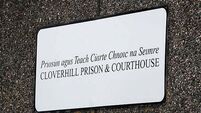The untold story of the widows of the 1916 rebellion revealed in new book

OF the many books that will be published to commemorate the Easter Rising’s centenary in 2016, few will be as riveting as Sinéad McCoole’s Easter Widows, which is published today. It gives the perspective of the widows of the rebels executed by the British government. There were seven widows, and their stories cast a fascinating light on their husbands.
McCoole, who has published notable books on Lady Lavery, has toiled on Easter Widows for 20 years. She painstakingly built relationships with the widows’ relatives, and mined secondary sources.
Remarkably, Fr Joseph Mallin, a child of one of the widows, is still alive. His father, Michael Mallin, wrote despairingly in his last hours about his curly-haired toddler son. “I cannot keep the tears back when I think that he will rest in my arms no more.” Fr Mallin’s sister, Maura, before she died, gave McCoole some of her most interesting first-hand testimony.
“When I met her, her family was very bitter against the State,” says McCoole. “I couldn’t understand why she felt like that. Now that the pension files have come to light last year, you see her mother writing from her sick-bed, asking for her money to be processed, and being told that she can’t get money for transportation. She can’t get money for books.
“Because her husband had not signed the Proclamation, she was given a reduced amount of money. Her husband was not considered to be a leader of the Rising. He was seen to have had a lesser role. Therefore, she didn’t get [enough] money, yet she was the only family member who had five children under the age of 12, being pregnant with her fifth child, Maura, who I met.
“When I realised that Maura’s mother was dead by the time Maura was 14, it made complete sense that the woman I was meeting was carrying all this resentment. Her mother had been so worried about money.”
Tom Clarke, along with James Connolly and Patrick Pearse, was shot on the first day of the executions, which were drawn out over 10 days in May, 1916. Clarke married his wife, Kathleen Daly, against the wishes of her family and friends. The origins of their romance were curious.
Clarke spent 15 years in prison for revolutionary activity, alongside Kathleen’s uncle, John Daly. From the age of six, Kathleen had listened to stories in her house about this noble rebel, Clarke, who had endured his penal labour with stoicism, though it left him with stooped shoulders. Yet when the 20-year-old Kathleen fell in love with Clarke, on his release from prison — he was 21 years her senior — her family was appalled that “the flower of the flock” might wed a man without “social or financial position”.
“Tom Clarke was so romantic and so in love with Kathleen,” says McCoole. “Their marriage was a partnership, yet his attitude about the Rising was, ‘I was always going to do this.’ He could operate with two parts of his brain almost.”
When Clarke left Kathleen behind on the first day of the Rising, Easter Monday, 1916, she spent it in their garden on Richmond Avenue, in Fairview, trying to distract herself by gardening. She later recalled she planted 100 cauliflowers that day.
According to Major John MacBride’s account, he was in Dublin that day to meet his brother, Anthony — who was due to be married two days later — for lunch at the Wicklow Hotel, just off Grafton St. When MacBride bumped into some Irish Volunteers and heard what was happening, he rowed in with the Jacob’s factory garrison, even though he was dressed in a blue suit and carrying a Malacca cane.
MacBride’s marriage to Maud Gonne — or “Maud Gone Mad,” as Dubliners called her during her later years of political agitation — had been a shambles. They had married in 1903, but had split in 1905. The divorce was never granted, so Maud Gonne raised their child, Sean, in Paris, only feeling it safe to return to Ireland after MacBride was executed.
One of the most illuminating passages of Easter Widows is the section about Grace Gifford’s courtship, and marriage to Joseph Mary Plunkett. It is nothing like the romance evoked in Jim McCann’s maudlin Irish love song, ‘Grace’.
Plunkett spent five years fruitlessly pursuing a girl from Gortahork, Co Donegal, called Columba O’Carroll, the daughter of a family friend. He was besotted with her, she bewildered by his advances. She disliked the love poems he wrote for her, which he printed on what he called The Columba Press.
Part of Plunkett’s reasoning for going to Germany and the United States, on dangerous, clandestine IRB business, while the First World War raged, was to purge her from his mind. “Is it not six months since I left my country, home, friends and for your sake?” he wrote in exasperation in September, 1915.
A month later, he returned to Ireland, met Grace Gifford, and within six weeks proposed to her. He was on the rebound. When Grace suggested the following Easter as a date for their wedding, Plunkett said the timing mightn’t suit, what with plans afoot for a revolution. He assured her that “they would be going into the Rising together”, a notion from which she recoiled. How little he knew of her. She was no political animal. Six weeks after their prison wedding, she posed for a photograph in Chicago’s New World newspaper. She was wearing a white dress and a fancy wristwatch, holding a kitten, looking like a bohemian. It was not the mournful air of the other Easter widows in their black weeds.
“She goes down in the pantheon of Irish heroines as this great love of his life. I grew up at a time when it was all Jim McCann and ‘Oh, Grace, just hold me in your arms and let this moment linger’, but when you research their story it isn’t remotely like what you expect it to be. There is evidence to suggest something else. When all the military-pensions material came to light, it actually showed that she was always looking for money and it was Joseph’s sister Geraldine’s opinion that Grace married him because she thought that he, as the eldest child, would inherit all the Plunkett money.”
Sinéad McCoole’s Easter Widows: Seven Irish Women Who Lived in the Shadow of the 1916 Rising is published by Doubleday Ireland. It costs €23.99.
Maud Gonne and Major John MacBride weren’t bothered with the normal carry-on of newly weds on honeymoon. They were trying to kill a monarch. The honeymooners went to Spain and Gibraltar to coincide with a visit by Edward VII in April, 1903. Maud Gonne even made a will beforehand, with provision that her eight-year-old daughter, Iseult, would be left in the care of a relative. When MacBride arrived home late and drunk, having failed “to do the deed”, a furious Maud Gonne packed her bags and left for Paris, saying he could follow her if he liked.
Maud Gonne hung a picture of her former lover, Lucien Millevoye, in their house, which MacBride demanded she take down. The dog Lucien gave to Maud Gonne slept in their bed every night. MacBride enraged Maud Gonne with his fecklessness and drinking, which featured heavily in their grubby divorce case, heard in a Parisian court in 1905, along with allegations that MacBride had adulterous sex with Maud Gonne’s 17-year-old half-sister as well as with their middle-aged house cook.












